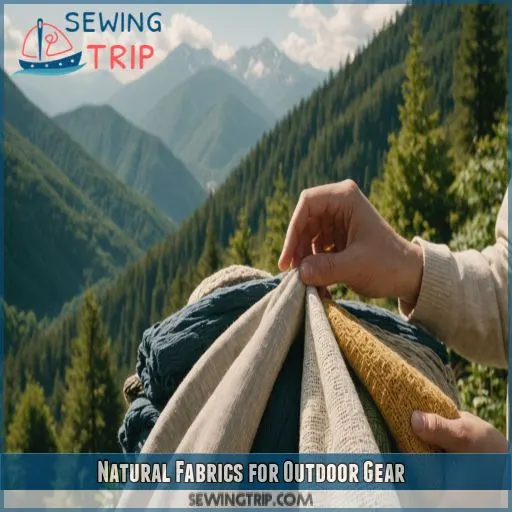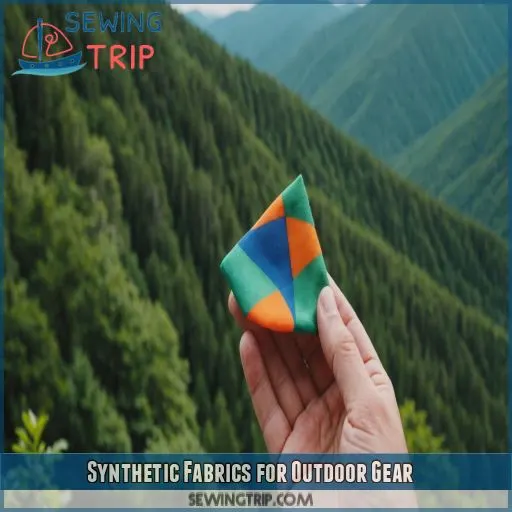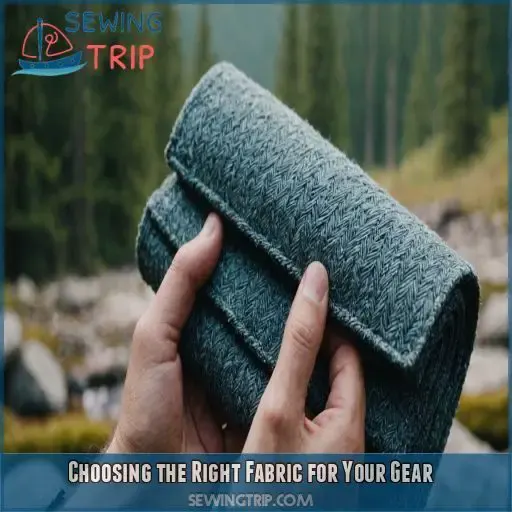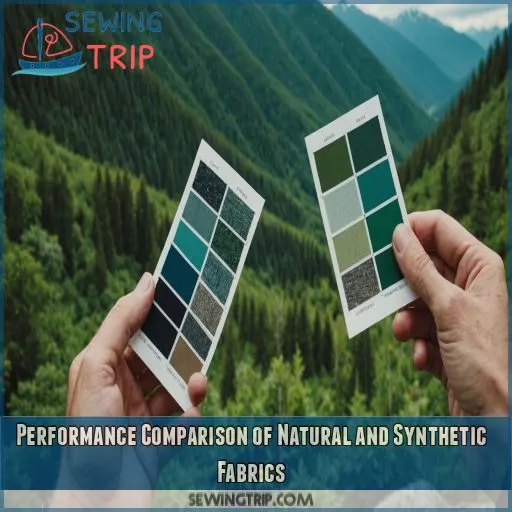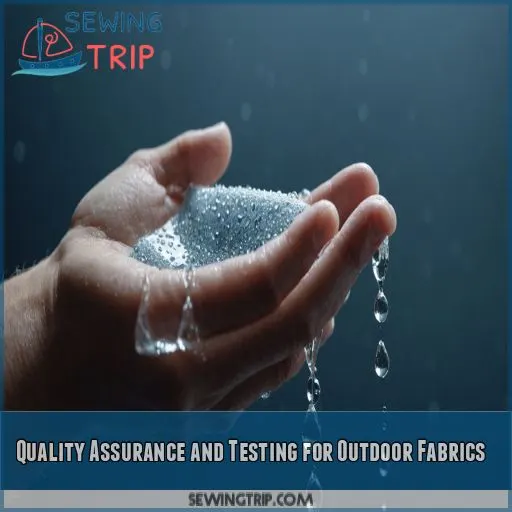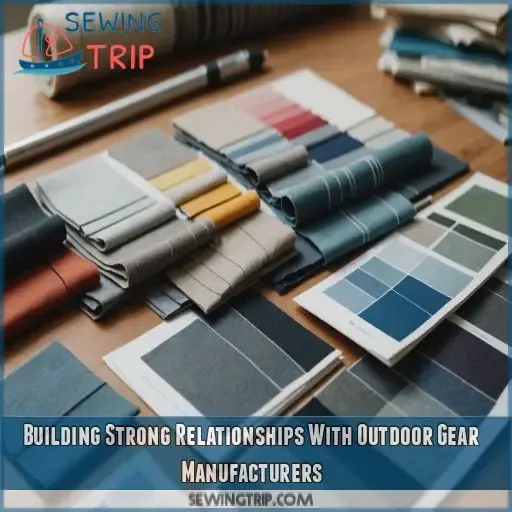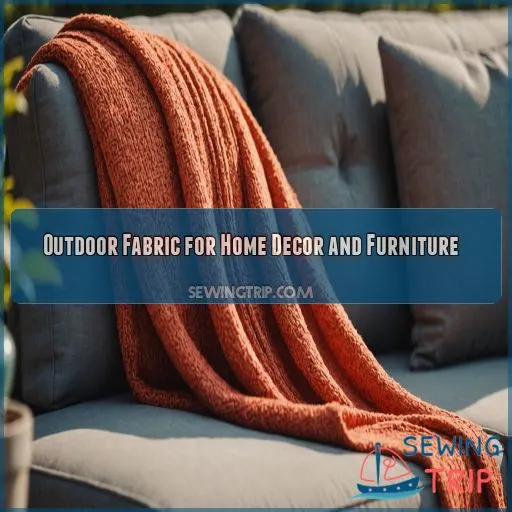This site is supported by our readers. We may earn a commission, at no cost to you, if you purchase through links.
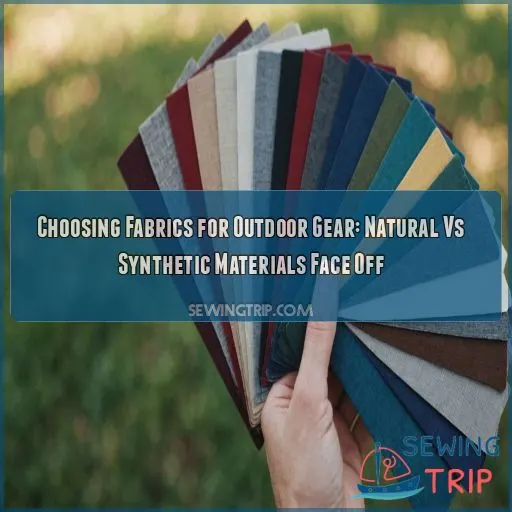
But, don’t worry, you’re not alone.
When it comes to selecting the perfect fabric for your outdoor adventures, you’ve got two main options: natural or synthetic.
Natural fabrics like cotton, wool, and bamboo offer breathability, Moisture-Wicking properties, and eco-friendliness.
Synthetic fabrics, on the other hand, provide durability, water resistance, and specialized performance features.
So, how do you choose?
Start by considering your specific needs and preferences.
Want to know more about finding the perfect fabric for your next adventure?
Table Of Contents
- Key Takeaways
- Natural Fabrics for Outdoor Gear
- Synthetic Fabrics for Outdoor Gear
- Choosing the Right Fabric for Your Gear
- Performance Comparison of Natural and Synthetic Fabrics
- Quality Assurance and Testing for Outdoor Fabrics
- Building Strong Relationships With Outdoor Gear Manufacturers
- Outdoor Fabric for Home Decor and Furniture
- Frequently Asked Questions (FAQs)
- Conclusion
Key Takeaways
- Don’t get caught with your pants down – choose fabrics that can handle the elements! Water-resistant fabrics will keep you dry for a bit, but waterproof ones are like having a superhero cape, shielding you from the elements for the long haul.
- Consider your adventure style: cotton for breathability, wool for warmth, or hemp for durability – your gear, your rules! Natural fabrics like cotton, wool, and bamboo are popular choices for outdoor enthusiasts because they offer breathability, moisture-wicking properties, and eco-friendly benefits.
- When it comes to outdoor gear, you want natural fabrics that are durable and versatile to withstand various climates and conditions. Look for fabrics with high tensile strength and abrasion resistance, and don’t sacrifice performance for style – you can have both with the right outdoor fabric!
- Choosing the right fabric is like being a detective: you need to investigate the clues! Consider durability, water resistance, breathability, and UV protection to make sure your gear holds up to the elements.
Natural Fabrics for Outdoor Gear
When you’re gearing up for your next outdoor adventure, the fabric of your gear can make all the difference in your comfort and performance. Natural fabrics like cotton, wool, and bamboo are popular choices for outdoor enthusiasts because they offer breathability, moisture-wicking properties, and eco-friendly benefits that can enhance your overall experience.
Benefits of Cotton, Wool, and Bamboo
When choosing natural fabrics for outdoor gear, consider cotton, wool, and bamboo. Cotton is a versatile and breathable option, while wool provides excellent insulation and temperature regulation. Bamboo is a sustainable choice with natural moisture-wicking properties. All three offer durability and performance, making them great alternatives to synthetic fabrics. Plus, they’re eco-friendly and gentle on skin.
Moisture-Wicking Properties and Breathability
When you’re outdoors, the last thing you want is to feel soggy and uncomfortable.
That’s where moisture-wicking fabrics come in – they’re designed to keep you dry and cool.
Look for natural fabrics like cotton, wool, and bamboo that allow for airflow and breathability.
These fabrics will help regulate your body temperature, so you can focus on mastering the great outdoors!
Eco-Friendly and Sustainable Options
If you’re looking for eco-friendly and sustainable options for outdoor gear, you have some fantastic choices. Look for fabrics made from recycled materials, biodegradable options like hemp, or those sourced from organic farming practices. Opting for sustainable fabrics helps reduce your carbon footprint and supports eco-friendly production methods. Your planet (and conscience) will thank you!
Durability and Versatility in Outdoor Environments
For outdoor gear, you want natural fabrics that are durable and versatile to withstand various climates and conditions. Look for fabrics with high tensile strength and abrasion resistance. Look after your gear with regular care and repair. With proper maintenance, natural fabrics can be incredibly durable and long-lasting, making them a great choice for outdoor enthusiasts.
Synthetic Fabrics for Outdoor Gear
You’re about to explore the world of synthetic fabrics, where durability and strength reign supreme. From water-resistant coatings to specialized Oxford fabrics, you’ll discover how synthetic materials can become your trusted sidekick in the great outdoors, providing the reliability and performance you need for your next adventure.
Oxford Fabric Properties and Benefits
Let’s talk about Oxford fabric. This synthetic superstar is known for its exceptional strength, breathability, and Water Resistance. Its basketweave structure makes it a top pick for outdoor gear, like backpacks and bags. With its durability testing and range of weights, Oxford fabric is perfect for withstanding the great outdoors. Its easy care is just the cherry on top!
Durability and Strength in Outdoor Conditions
When you’re heading out into the wild, you need gear that can handle anything Mother Nature throws at it. Here’s what to look for in fabrics that are built to last:
- Tear resistance: Ballistic nylon Oxford is a top contender, resisting snags and tears with ease.
- Abrasion resistance: Look for fabrics with a high rub rating to minimize wear and tear.
- Weather testing: Check if the fabric has been put through its paces in extreme conditions to see how it holds up.
- Repairability: Consider fabrics that are easy to repair to extend their lifespan.
Water Resistance and Weatherproofing Options
If you’re worried about rain and wet weather, you’ve got options. Look for synthetic fabrics with DWR coatings, waterproof membranes, or fabric laminates. Don’t forget to seal those seams for extra protection. A weatherproof finish can be a lifesaver on a rainy day. By prioritizing water resistance, you’ll be mastering the art of moisture management in no time.
Specialized Oxford Fabrics for Specific Gear Types
If you’re looking for a specialized Oxford fabric, you have options. Here are three to check out:
- Ballistic Nylon Oxford: ultra-durable and water-resistant, perfect for backpacks and duffel bags.
- Waterproof Oxford: ideal for gear that needs to stay dry, like tents and outdoor apparel.
- Insulated Oxford: provides warmth and protection for camping trips and colder climates.
Choosing the Right Fabric for Your Gear
Choosing the right fabric for your gear is key to comfortable and stress-free outdoor adventures.
You’ll want to think about things like how well the fabric manages moisture, how breathable it is, and how durable it is.
Whether you’re a fan of natural fibers like cotton and wool or prefer the versatility of synthetics like nylon, we’ve got you covered with our expert tips on selecting the perfect fabric for your outdoor gear.
Factors to Consider for Natural Fabrics
When choosing natural fabrics for your outdoor gear, consider factors like durability, sustainability, comfort, care, and cost. Opt for natural fibers from renewable resources to minimize environmental impact. Think about the activities you’ll be doing and the weather conditions you’ll face. Natural fabrics like wool and bamboo offer great odor resistance and UV protection, too!
Factors to Consider for Synthetic Fabrics
Time to talk synthetic fabrics! When choosing the right one for your outdoor gear, consider these key factors:
- Durability: Can it withstand rough handling and harsh weather?
- Water Resistance: Will it keep you dry in a downpour or snowstorm?
- Breathability: Can it prevent overheating and discomfort?
Think about your needs and prioritize these factors for a successful outdoor adventure!
Understanding Fabric Weights and Deniers
Choosing the right fabric weight and denier for your outdoor gear can be overwhelming.
Don’t worry, I’ve got you covered!
A higher denier (like 1000D) means thicker, more durable fabric, perfect for rugged adventures.
Lighter deniers (like 400D) are great for backpacking or day trips.
Consider your activities and fabric uses to pick the perfect outdoor fabric by the yard.
Care and Maintenance Tips for Outdoor Fabrics
Now that you’ve chosen the perfect fabric for your outdoor gear, let’s talk care and maintenance! To keep your fabrics looking fresh, wash them in cold water with mild soap, and dry them on low heat. For tough stains, try a fabric-specific cleaner. Store your gear in a cool, dry place, and repair any tears ASAP to prevent further damage.
Performance Comparison of Natural and Synthetic Fabrics
When choosing fabrics for your outdoor gear, you’re likely weighing the pros and cons of natural and synthetic materials – and for good reason.
You want gear that’s comfortable, durable, and performs well in all conditions.
That’s why understanding the differences between natural and synthetic fabrics is key.
In this section, we’ll break down how these fabrics stack up against each other when it comes to moisture management, environmental impact, durability, and overall comfort, so you can make an informed decision for your next adventure .
Moisture Management and Breathability
When talking about keeping dry and comfortable, natural fabrics like cotton and wool are the winners. They pull moisture away from your body, keeping you feeling good. Synthetic fabrics can make you feel clammy and stuck. Look for breathable vs. waterproof options and opt for air drying and gentle cleaning to keep your outdoor gear in top shape.
Environmental Impact and Sustainability
When you’re picking out fabric, think about how it affects our planet. Natural fabrics break down naturally and use less energy to make, while synthetic fabrics depend on things we can’t replace. Here are four things to keep in mind for eco-friendly choices:
- Look for recycled fabrics: Reduce waste by choosing materials made from things that have been recycled.
- Opt for eco-friendly production: Support companies that put sustainability first and use ways to make things that don’t harm the environment.
- Choose biodegradable options: Pick materials that break down easily and cut down on stuff going into landfills.
- Check for green certifications: Make sure the fabric you choose meets strict environmental standards, so you can feel good about your choice.
Durability and Abrasion Resistance
If you’re looking for fabric that can stand up to wear and tear, you need to consider durability and abrasion resistance. Here’s a quick rundown of how natural and synthetic fabrics stack up:
| Fabric Type | Denier Count | Abrasion Resistance |
|---|---|---|
| Cotton | 100-200 | Low-Moderate |
| Nylon | 400-600 | High |
| Polyester Blend | 200-400 | Moderate-High |
Look for fabrics with high denier counts and ripstop weaves for added durability. Abrasion tests can also give you an idea of how well a fabric will hold up to wear and tear.
Comfort and Versatility in Outdoor Activities
For comfort and versatility in outdoor activities, natural fabrics like cotton, wool, and bamboo are hard to beat. They breathe, wick moisture, and feel amazing against your skin. But synthetic fabrics have their own perks, like durability and water resistance. Ultimately, the choice depends on your adventure style.
- Choose natural fabrics for low-key camping trips or everyday wear.
- Opt for synthetic fabrics for intense hiking or wet weather.
- Consider layering for maximum comfort and versatility.
- Look for sustainable fabrics that are gentle on the planet.
- Don’t sacrifice performance for style – you can have both with the right outdoor fabric!
Quality Assurance and Testing for Outdoor Fabrics
When you’re picking out fabrics for outdoor gear, it’s really important to check out the quality assurance and testing process to make sure you’re getting the best materials for your needs. By understanding the different tests, like tensile strength, abrasion resistance, and colorfastness, you can make smart decisions about the fabrics that will hold up well outside.
Industry Standards for Fabric Testing
When choosing outdoor fabrics, you want to know they can withstand the elements. That’s where industry standards for fabric testing come in. Look for ISO certifications, which mean the fabric meets rigorous lab testing standards for textile quality. Regulations also cover resistance to stains, mildew, mold, sun, and weather. Now, you can adventure with confidence!
Tensile Strength, Abrasion, and Pilling Resistance
When choosing outdoor fabrics, you want to make sure they can handle the elements and your adventures. That’s where tensile strength, abrasion, and pilling resistance come in. Look for fabrics that have been tested for these qualities, and check the results. This will give you a good idea of how well your gear will hold up to wear and tear.
Colorfastness, Water Resistance, and UV Protection
Now that you’ve got a handle on tensile strength, abrasion, and pilling resistance, let’s talk colorfastness, water resistance, and UV protection. You want your outdoor gear to stay vibrant and protected, right? Here are some key considerations:
- UV-resistant dyes: Look for fabrics with built-in UV protection to prevent fading.
- Waterproofing techniques: Choose fabrics with water-repellent coatings or membranes.
- Fabric finishes: Some fabrics have special finishes that enhance water resistance and UV protection.
- Colorfastness testing: Make sure the fabric’s colors won’t bleed or run when exposed to water or sunlight.
Importance of Partnering With Reputable Manufacturers
When choosing outdoor fabric, picking the right manufacturers is really important. You want to make sure your gear is high-quality and made responsibly. Look for companies that prioritize quality assurance, ethical sourcing, and long-term partnerships. This will give you peace of mind and a durable product that will last for years to come.
| What to Look for | Why it Matters |
|---|---|
| Quality assurance | Makes sure your gear meets high standards |
| Ethical sourcing | Supports fair labor practices and eco-friendly materials |
| Long-term partnerships | Fosters trust and consistency in production |
| Innovation | Drives creation of cutting-edge, high-performance fabrics |
| Trust building | Establishes a strong foundation for future collaborations |
Building Strong Relationships With Outdoor Gear Manufacturers
You’re likely no stranger to the importance of teamwork in creating amazing outdoor gear. By building strong relationships with manufacturers, you can stay ahead of the game, ensuring your fabrics meet the highest standards of quality, innovation, and sustainability.
Staying Informed About Market Trends and Advancements
To stay ahead in the outdoor gear game, attend industry events and follow fabric innovations, sustainability efforts, and consumer needs.
Keep an eye on your competitors and analyze market trends.
Think beyond traditional uses – outdoor fabric can elevate your bedroom, living room, or even kitchen decor!
Maintaining Quality Control and Consistency
You’re building relationships with outdoor gear manufacturers – congratulations!
To make sure you’re getting the quality you need, set up a system that includes regular supplier audits, fabric testing, and production monitoring.
Check that your suppliers stick to fabric testing standards, like those for water resistance and UV protection.
Consistency is key to producing high-quality outdoor gear that can withstand the elements.
Investing in Research and Development
Now that you’ve got quality control down, it’s time to supercharge your outdoor gear game by investing in research and development. Allocate a budget to explore future trends, sustainable materials, and innovative production methods. By doing so, you’ll stay ahead of the curve and attract forward-thinking partners who share your passion for eco-friendly outdoor fabrics.
Collaborative Product Development and Customization
You’re working with outdoor gear manufacturers, it’s important to collaborate on custom fabric blends that meet specific needs. By sharing knowledge and expertise, you can create innovative materials that excel in various environments, from backyards to beaches. Here are some benefits of design collaboration:
- Develop materials that balance durability and comfort
- Enhance product performance through prototyping and testing
- Integrate customer feedback into the design process
- Drive innovation in material science and technology
- Create products that exceed customer expectations and build brand loyalty
Outdoor Fabric for Home Decor and Furniture
You’re likely no stranger to the versatility of outdoor fabric, but have you considered bringing its benefits indoors? By choosing the right outdoor fabric, you can enjoy durability, stain resistance, and ease of cleaning in your home decor and furniture, perfect for busy households with kids or pets.
Benefits of Using Outdoor Fabric Indoors
You’re considering using outdoor fabric indoors? Genius! You’ll get the benefits of durability, stain-resistance, and versatility without sacrificing style. Plus, it’s often budget-friendly and low-maintenance. Imagine having a backyard or pool-inspired vibe in your living room, or a beachy feel without the water damage worries. Outdoor fabric can bring that carefree spirit inside, effortlessly.
Popular Sources for Outdoor Fabric by the Yard
Now that you’ve fallen in love with using outdoor fabric indoors, where can you get your hands on some amazing materials? Serena and Lily offer Sunbrella blue for $38/yard, while Ballard Designs feature classic stripes for $24.79/yard. Amazon and online marketplaces also offer a variety of options, so start browsing for your next DIY project!
Tips for Choosing the Right Outdoor Fabric
When choosing the right outdoor fabric, consider your backyard, pool, or beach lifestyle. Think about fabric weight, durability, water resistance, UV protection, and breathability. Don’t sacrifice style for functionality! Look for fabrics that balance both. Look for outdoor fabric that suits your needs. Check if the fabric can withstand your fun in the sun.
Ideas for Using Outdoor Fabric in Home Decor
Now that you’ve picked the perfect outdoor fabric, it’s time to get creative!
Use it to revamp your backyard, pool, or beach decor with DIY projects like upholstery, pillows, and drapes.
For budget-friendly options, consider repurposing old furniture or scouting thrift stores.
As an outdoor enthusiast, you’ll love how easy it is to clean and maintain your new fabric creations, giving you more time to enjoy the great outdoors.
Frequently Asked Questions (FAQs)
What type of outdoor fabric should I Choose?
You’re on the hunt for the perfect outdoor fabric, but where do you start? Consider your adventure style: cotton for breathability, wool for warmth, or hemp for durability – your gear, your rules!
Can performance fabric be used outside?
You can use performance fabric outside, but be aware that not all performance fabrics are created equal. Check the specs for water resistance, UV protection, and durability to make sure it can withstand the elements.
What are the best synthetic fibers for outdoor clothing?
You’re gearing up for adventure! For outdoor clothing, look for polyester, nylon, or spandex blends that offer breathability, moisture-wicking, and quick-drying properties to keep you comfortable and confident.
How do I choose the best nylon fabric for outdoor gear?
Choosing the best nylon fabric for outdoor gear can be overwhelming, but don’t sweat it! Look for high-denier nylon with a water-repellent coating, and consider factors like breathability, UV protection, and durability to make sure your gear holds up to the elements.
What is the best material for outdoor gear?
Like a trusted companion on a wild adventure, the best material for outdoor gear is one that’s got your back – literally! Choose natural fabrics like cotton, wool, or hemp for breathability, durability, and eco-friendliness.
What fabric holds up the best outdoors?
You’re looking for a fabric that’s as tough as you are. Consider natural fibers like cotton, wool, or hemp for their breathability and durability. Oxford fabric also shines for its exceptional strength and water resistance.
What are the 4 things to consider when choosing fabric?
Choosing fabric is like being a detective: you need to investigate the clues! Consider durability, like a fabric’s denier count; water resistance, such as DWR coating; breathability, like mesh layers; and UV protection, like built-in UPF Ratings.
What is the most sun resistant fabric?
You’re looking for the ultimate sun warrior! Among natural fabrics, hemp is your best bet for sun resistance – it’s like having a personal sunscreen in fabric form, thanks to its natural UV-blocking properties.
How do I care for and maintain my outdoor fabric gear?
To care for your outdoor fabric gear, start by checking the manufacturer’s label for specific instructions. Generally, you’ll want to hand wash or spot clean stains, avoid harsh chemicals, and store gear in a dry, well-ventilated area.
What are the differences between water-resistant and waterproof fabrics?
Imagine being caught in a surprise rainstorm – yikes! Water-resistant fabrics will keep you dry for a bit, but waterproof ones are like having a superhero cape, shielding you from the elements for the long haul.
Can I use outdoor fabrics for making childrens clothing and accessories?
You can use outdoor fabrics for kids’ clothing and accessories, but consider factors like softness, breathability, and potential allergies. Choose fabrics that balance durability and comfort, so your little explorers stay safe and free to play.
How do I choose the right thread and stitching for outdoor fabrics?
Don’t worry, choosing the right thread and stitching for outdoor fabrics isn’t as scary as it seems! Simply match your thread type to the fabric’s durability and purpose, and opt for reinforced stitching for high-wear areas.
Are there any eco-friendly alternatives to waterproof coatings and treatments?
You can opt for eco-friendly alternatives like PFC-free treatments from Nikwax or Revivex , or consider brands using Gore’s new PFC-free waterproofing ePE Membrane . Your outdoor gear – and the planet – will thank you!
Conclusion
Now that the dust has settled in the battle between natural and synthetic fabrics, you’re equipped to make an informed decision when choosing fabrics for outdoor gear.
It’s not about crowning a champion, but about selecting the best material for your adventure.
Consider your needs, weigh the pros and cons, and don’t be afraid to mix and match.
With the right fabric, you’ll be ready to take on the great outdoors in style and comfort.

